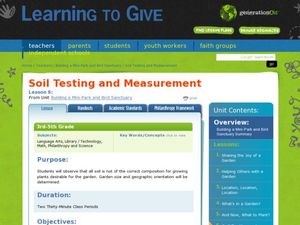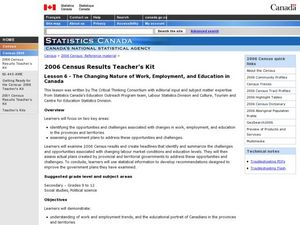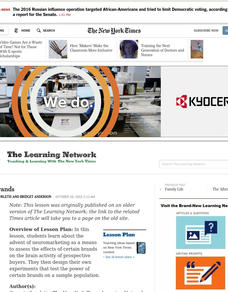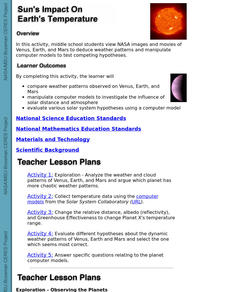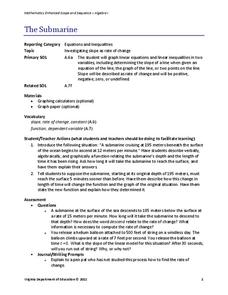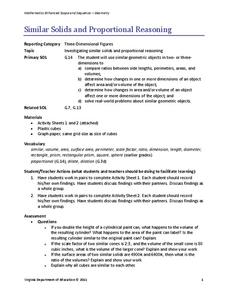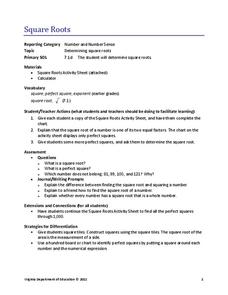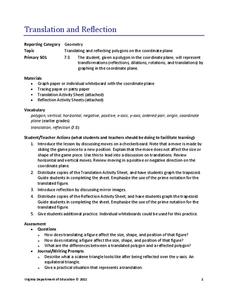Curated OER
Soil Testing and Measurement
Students prepare their garden plot. In this gardening lesson, students use the Internet or book on plants to make sure the plants they have selected will be able to grow in their garden. The students assess and mark out the garden...
Curated OER
Subtraction Action!
Students work together in teams to create subtraction problems based on the numbers their teacher gives them. They solve the problem in question. They complete timed tests to practice their skills more.
Curated OER
Sit on It!
Students design and create a chair. Students look at current stool design and come up with a prototype from donated materials. Students then test their chair in various settings.
Curated OER
The Changing Nature of Work, Employment, and Education in Canada.
High schoolers identify the effect caused by change of employment and education. In this statistics lesson, students analyze data and draw conclusions. This assignment tests high schoolers' ability to use data correctly.
Curated OER
Garden Variety Geometry
Students prepare to take the GED by reviewing basic math concepts. In this geometry instructional activity, students review vocabularies such as formula, perimeter, circumference and other important geometric terms. They convert between...
Curated OER
Brain Brands
Students explore the advent of neuromarketing as a means to assess the effects of certain brands on the brain activity of prospective buyers. They design their own experiments that test the power of certain brands on a sample population.
Curated OER
Sun's Impact On Earth's Temperature
Students view NASA images and movies of Venus, Earth, and Mars to deduce weather patterns and manipulate computer models to test competing hypotheses. They manipulate computer models to investigate the influence of solar distance and...
Curated OER
Anchoring Activities - Various Subjects (K-5)
Teachers create different activities and differentiate them to meet the students' needs. In this differentiation lesson, teachers do activities such as accelerated reader, sunshine math, problem of the day, around the world or vocabulary...
Curated OER
Mathematics in Robotics
Students build and create using math. For this geometry lesson, students differentiate between congruent and similarity as they observe polygons. They create robots with different functions using properties of geometry.
Curated OER
Money and Business
Third graders use play money to complete tasks that allow them to see if the budget they came up with works. In this budget lesson plan, 3rd graders create their own budget and test it out with the play money.
Curated OER
Geometric Basketball Court
Pupils calculate the area and perimeter of a basketball court. In this geometry lesson, students differentiate between similarity and congruence of geometric objects. They test conjectures and use it to solve problems.
Curated OER
Graphing and the Coordinate Plane
Students gain practice reading coordinates and plotting points by participating in the Coordinates! Game. They demonstrate and test their skills with graph paper and the Maze Game.
Curated OER
Probability
Students complete various activities for probability. In this probability lesson plan, students use coins, cubes, peanut butter and jelly, playing cards, number cubes, darts, and a Gauss Curve to study probability. Students must orally...
Curated OER
Arranging Decimals In Ascending/Descending Order
In this on-line worksheet, students complete 10 multiple choice questions where they arrange decimals in ascending or descending order. Students can check their answers at the end of the worksheet.
Curated OER
Practice Quiz: Least Common Multiple
Use this least common multiple activity to have your learners complete two mutliple choice questions containing one and two-digit numbers. Answers are provided online.
Virginia Department of Education
Factoring for Zeros
Relate factors to zeros and x-intercepts. Scholars first graph quadratics in both standard and factored forms to see that they are the same. They go on to use the graphs to see the relationship between factors and x-intercepts.
Virginia Department of Education
Scientifically Speaking
Explore the connection between operations with scientific notation and the laws of exponents. Scholars work on a set of word problems involving operations with scientific notation. Along the way, they consider how the laws of exponents...
Virginia Department of Education
The Submarine
Submerge yourself in the study of slope. Scholars investigate a situation involving slope and the rate of change of a submarine. An additional example further explores the concept of slope by changing one of the conditions of the submarine.
Virginia Department of Education
Similar Solids and Proportional Reasoning
Double the dimensions, quadruple the surface area. Pairs build similar prisms and compare the ratios of their surface areas and volumes to the ratio of the heights. Given two similar cones, partners determine the ratios of the lateral...
Virginia Department of Education
Square Roots
Square away any doubts about using a new resource. Pupils learn about squares and square roots in the mini-instructional activity. They complete a worksheet identifying roots of perfect squares up to 400.
Virginia Department of Education
Ordering Fractions, Decimals, and Percents
Order up a resource on comparing rational numbers. Scholars order fractions, decimals, and percents by converting to a single form. They conduct a cut-and-paste activity ordering three sets of rational numbers.
Virginia Department of Education
Rotation
Rotate this resource into your lesson plans. Scholars rotate polygons in the coordinate plane by multiples of 90 degrees. They then compare the original and new figures to develop conjectures about coordinate points after rotations.
Virginia Department of Education
Dilation
Open up your pupils' eyes and minds on dilations. Scholars perform dilations on a trapezoid on the coordinate plane. They compare the image to the preimage and develop generalizations about dilations.
Virginia Department of Education
Translation and Reflection
Bring about the change you want to see in the world or at least in your lesson plans. Young mathematicians learn about translation and reflections by applying them to polygons on the coordinate plane. Results provide data to develop...


